How art thou fallen from heaven, O Lucifer, son of the morning! how art thou cut down to the ground, which didst weaken the nations! For thou hast said in thine heart, I will ascend into heaven, I will exalt my throne above the stars of God: I will sit also upon the mount of the congregation, in the sides of the north: I will ascend above the heights of the clouds; I will be like the most High. Yet thou shalt be brought down to hell, to the sides of the pit. (Isaiah 14:12-15)
Now the serpent was more subtle than any beast of the field which the LORD God had made. And he said unto the woman, Yea, hath God said, Ye shall not eat of every tree of the garden? And the woman said unto the serpent, We may eat of the fruit of the trees of the garden: but of the fruit of the tree which is in the midst of the garden, God hath said, Ye shall not eat of it, neither shall ye touch it, lest ye die. And the serpent said unto the woman, Ye shall not surely die: for God doth know that in the day ye eat thereof, then your eyes shall be opened, and ye shall be as gods, knowing good and evil. And when the woman saw that the tree was good for food, and that it was pleasant to the eyes, and a tree to be desired to make one wise, she took of the fruit thereof, and did eat, and gave also unto her husband with her; and he did eat. And the eyes of them both were opened, and they knew that they were naked; and they sewed fig leaves together, and made themselves aprons. (Genesis 3:1-7)
The word occult comes from the Latin occultus, meaning knowledge of the secret, or hidden knowledge; the Greek term for the word is esoteric.
And it came to pass, when men began to multiply on the face of the earth, and daughters were born unto them, that the sons of God saw the daughters of men that they were fair; and they took them wives of all which they chose. And the LORD said, My spirit shall not always strive with man, for that he also is flesh: yet his days shall be an hundred and twenty years. There were giants in the earth in those days; and also after that, when the sons of God came in unto the daughters of men, and they bare children to them, the same became mighty men which were of old, men of renown. And God saw that the wickedness of man was great in the earth, and that every imagination of the thoughts of his heart was only evil continually. And it repented the LORD that he had made man on the earth, and it grieved him at his heart. And the LORD said, I will destroy man whom I have created from the face of the earth; both man, and beast, and the creeping thing, and the fowls of the air; for it repenteth me that I have made them. But Noah found grace in the eyes of the LORD. (Genesis 6)
The giants in the earth in those days, the mighty men of renown are also referred to as the Nephilim. Prior to the flood, fallen angels had relations with human women which resulted in unnaturally giant and powerful offspring, and corrupted human bloodlines. 1,500 years after the fall of man, God destroyed the earth with a great flood to purge all the wickedness. At that point in history all of the man’s accomplishments were lost in the flood; the depth of the occult from the first era of our history became an everlasting mystery.
And the sons of Noah, that went forth of the ark, were Shem, and Ham, and Japheth: and Ham is the father of Canaan. These are the three sons of Noah: and of them was the whole earth overspread… Now these are the generations of the sons of Noah, Shem, Ham, and Japheth: and unto them were sons born after the flood. The sons of Japheth; Gomer, and Magog, and Madai, and Javan, and Tubal, and Meshech, and Tiras. And the sons of Gomer; Ashkenaz, and Riphath, and Togarmah. And the sons of Javan; Elishah, and Tarshish, Kittim, and Dodanim.
By these were the isles of the Gentiles divided in their lands; every one after his tongue, after their families, in their nations. And the sons of Ham; Cush, and Mizraim, and Phut, and Canaan. And the sons of Cush; Seba, and Havilah, and Sabtah, and Raamah, and Sabtechah: and the sons of Raamah; Sheba, and Dedan.
And Cush begat Nimrod: he began to be a mighty one in the earth. He was a mighty hunter before the LORD: wherefore it is said, Even as Nimrod the mighty hunter before the LORD. And the beginning of his kingdom was Babel, and Erech, and Accad, and Calneh, in the land of Shinar. Out of that land went forth Asshur, and builded Nineveh, and the city Rehoboth, and Calah, and Resen between Nineveh and Calah: the same is a great city. (Genesis 9,10)
The name Babylon is derived from BAB-ILU, which means the portal of the gods, or portal to the gods. The word portrays a means of access to the gods which is contrary to God’s prescribed plan of salvation. In Babylon, access is granted through the system and not by faith in Jesus Christ. It is a system where salvation by works replaces salvation by faith.
To add to the confusion (which is also implied in the name Babylon), the Babylonians believed in an entire pantheon of gods, thus providing more than one intercessor, which also makes the ministry of Jesus of non effect. The Babylonian system of worship has ever been a snare to God’s people, as it is more in tune with human nature to rely on salvation by works than on salvation by grace. From the very beginning, these two systems of worship have been in confrontation with each other.
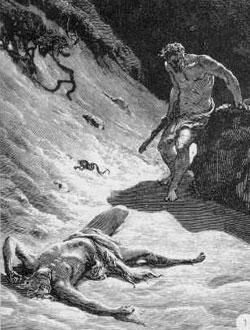 The story of Cain and Abel illustrates this point. Abel listened to the divine directive and brought a lamb without blemish (a symbol of the Messiah) as an offering, but Cain brought the fruits of his labor. When the offering of Abel was accepted by God, the anger of Cain was aroused; and ever since this first confrontation between these two systems of worship, the fires of religious intolerance and persecution have been burning.
The story of Cain and Abel illustrates this point. Abel listened to the divine directive and brought a lamb without blemish (a symbol of the Messiah) as an offering, but Cain brought the fruits of his labor. When the offering of Abel was accepted by God, the anger of Cain was aroused; and ever since this first confrontation between these two systems of worship, the fires of religious intolerance and persecution have been burning.
Ancient Babylon, according to the scriptures, was the pride of the Chaldeans, it was larger and more impressive than any of the ancient cities, and it was the center of ancient worship. Babylon reached the height of its power and glory under Nebuchadnezzar, and ancient inscriptions on clay tablets tell the story of how his father (Nabopolasser) and he restored the ancient tower of Babel which epitomized salvation by self:
At the time Marduk commanded me to build the tower of Babel, which had become weakened by time and fallen into disrepair; he commanded me to ground its base securely on the breast of the underworld, whereas its pinnacles should strain towards the skies. (Nabopolasser)
To raise up the top of the E-temen-an-ki that it may rival heaven, I laid my hand. (Nebuchadnezzar)
Approximately 300 years before its destruction by Xerxes, the prophet Isaiah said this great city would one day fall, never to be inhabited again.
And Babylon, the glory of kingdoms, the beauty of the Chaldees’ excellency, shall be as when God overthrew Sodom and Gomorrah. It shall never be inhabited, neither shall it be dwelt in from generation to generation: neither shall the Arabian pitch tent there; neither shall the shepherds make their fold there. (Isaiah 13)
In spite of this prophecy, there have been attempts to rebuild Babylon. Alexander the Great tried to restore the tower of Babel to its original glory and make the city his capital in 330 BC, but before he could begin he died. In modern history, Saddam Hussein of Iraq also made attempts to restore Babylon, a work he began in the 1980’s. He used approximately 60 million bricks in the process and had his name engraved every three meters so that posterity would remember him. However, he may have read the prophecies of Isaiah, as his restorations were not an attempt to re-inhabit the city, since he had his palace built on the other side of the Euphrates River.
The Babylonian system of worship, however, has been maintained to this day. The ancient Chaldeans worshipped a pantheon of male and female gods representing the sun god. There were largely three aspects to this system of sun worship, representing the father, mother, and the son. These were their gods:
Bel
The oldest and mightiest god of Babylonia, Lord of the World, father of the gods, Creator, and Lord of the City of Nipur; and Hea, maker of fate, Lord of the Deep, God of Wisdom and esoteric Knowledge, and Lord of the city of Eridu. The wife of Bel, or his female aspect (Sakti), was Beltis, the mother of the great gods, and the Lady of the city of Nipur.
[Merodach is] a Chaldean name for the God of Babylon, the Bel of later times. He is the son of Davkina, goddess of the lower regions, or the earth, and of Hea, God of the Seas and Hades with the Orientalists; but esoterically and with the Akkadians, the Great God of Wisdom, ‘he who resurrects the dead’. Hea, Ea, Dagon or Oannes and Merodach are one. Helena Blavatsky, The Theosophical Glossary
Ninus
The son, who was also worshipped as Tammuz; a Syrian deity worshiped by idolatrous Hebrews as well as by Syrians. The women of Israel held annual lamentations over Adonis (that beautiful youth being identical with Tammuz). The feast held in his honor was solstitial, and began with the new moon, in the month of Tammuz (July), taking place chiefly at Byblos in Phœnicia; but it was also celebrated as late as the fourth century of out era at Bethlehem, as we find St. Jerome writing his lamentations in these words: ‘Over Bethlehem, the grove of Tammuz, that is of Adonis, was casting its shadow! And in the grotto where formerly the infant Jesus cried, the lover of Venus was being mourned.’ Indeed, in the Mysteries of Tammuz or Adonis a whole week was spent in lamentations and mourning. The funeral processions were succeeded by a fast, and later by rejoicings; for after the fast Adnois-Tammuz was regarded as raised from the dead, and wild orgies of joy, of eating and drinking, as now in Easter week, went on uninterruptedly for several days. Helena Blavatsky, The Theosophical Glossary
Ishtar, Astarte, Rhea
The Babylonian Venus, called the eldest of heaven and earth, and daughter of Anu, the god of heaven. She is the goddess of love and beauty. The planet Venus, as the evening star, is identified with Ishtar, and as the morning star with Anunit, the goddess of the Akkads. There exists a most remarkable story of her descent into Hades, on the sixth and seventh Assyrian tiles or tablets deciphered by the late G. Smith. Any Occultist who reads of her love for Tammuz, his assassination by Izdubar, the despair of the goddess and her descent in search of her beloved through the seven gates of Hades, and finally her liberation from the dark realm, will recognize the beautiful allegory of the soul in search of the Spirit.
[Astarte is] the Syrian goddess, the consort of Adon, or Adonai.
As Bel or Belus (Baal) was the name of the great male divinity of Babylon, so the female divinity was called Beltis. This name has been found in Nineveh applied to the mother of the gods; and in a speech attributed to Nebuchadnezzar, both titles Belus and Beltis are conjoined as the titles of the great Babylonian god and goddess. The Greek Belus, as representing the highest title of the Babylonian god, was undoubtedly Baal, The Lord. Beltis, therefore, as the title of the female divinity, was equivalent to Baalti, which, in English, is My Lady, in Latin, Mea Domina, and, in Italian, is corrupted into the well known Madonna. Helena Blavatsky, The Theosophical Glossary
The mother goddess is also referred to as the queen of heaven, and the wrath subduer. Mother and child worship was the basis of many ancient religions. Moreover, the child was worshipped as both husband and son of the mother goddess.
Zoroaster
Zero in Chaldee, the seed, though we have seen reason to conclude that in Greek it sometimes appeared as Zeira, quite naturally passed also into Zoro, as may be seen from the change of Zerubbabel in the Greek Septuagint to Zoro-babel; and hence Zuro-ashta, the seed of the woman became Zoroaster, the well known name of the head of the fire-worshipers. Zoroaster’s name is also found as Zeroastes. The reader who consults the able and very learned work of Dr. Wilson of Bombay, on the Parsi Religion, will find that there was a Zoroaster long before that Zoroaster who lived in the reign of Darius Hystaspes. In general history, the Zoroaster of Bactria is most frequently referred to; but the voice of antiquity is clear and distinct to the effect that the first and great Zoroaster was an Assyrian or Chaldean, and that he was the founder of the idolatrous system of Babylon, and therefore Nimrod. It is equally clear also in stating that he perished by a violent death, even as was the case with Nimrod, Tammuz, or Bacchus. The identity of Bacchus and Zoroaster is still further proved by the epithet Pyrisporus, bestowed on Bacchus in the Orphic Hymns. When the primeval promise of Eden began to be forgotten, the meaning of the name Zero-ashta was lost to all who knew only the exoteric doctrine of paganism; and as ashta signified fire in Chaldee, as well as the woman, and the rites of Bacchus had much to do with fire-worship, Zero-ashta came to be rendered the seed of fire; and hence the epithet Pyrisporus, or Ignigena, fire-born, as applied to Bacchus. From this misunderstanding of the meaning of the name Zero-ashta, or rather from its willful perversion by the priests, who wished to establish one doctrine for the initiated, and another for the profane, came the whole story about the unborn infant Bacchus having been rescued from the flames that consumed his mother Semele, when Jupiter came in his glory to visit her. Alexander Hislop, The Two Babylons
Bacchus
Bacchus is exoterically and superficially the god of wine and the vintage, and of licentiousness and joy; but the esoteric meaning of this personification is more abstruse and philosophical. He is the Osiris of Egypt, and his life and significance belong to the same group as the other solar deities, all sin-bearing, killed and resurrected; e.g., as Dionysos or Atys of Phrygia (Adonis or the Syrian Tammuz), as Ausonius, Baldur, etc. All these were put to death, mourned for, and restored to life. The rejoicings for Atys took place at the Hilaria on the pagan Easter, March 15. Ausonius, a form of Bacchus, was slain ‘at the vernal equinox, March 21st, and rose in three days.’ Tammuz, the double of Adonis and Atys, was mourned by the women at the grove of his name ‘over Bethlehem, where the infant Jesus cried’, says St. Jerome. Bacchus is murdered and his mother collects the fragments of his lacerated body as Isis does those of Osiris, and so on. Dionysos Iacchus, torn to shreds by the Titans, Osiris, Krishna, all descended into Hades and returned again. Astronomically, they all represent the Sun; physically they are all emblems of the ever-resurrecting Soul (the Ego in its reincarnation); spiritually, all the innocent scapegoats, atoning for the sins of mortals, their own earthly envelopes, and in truth, the poeticized image of DIVINE MAN, the form of clay informed by its God. Helena Blavatsky, The Theosophical Glossary
The son, or male component, of the mother-child deities, is the counterfeit Savior, and thus the counterfeit of Jesus Christ. All the titles pertaining to Jesus were also used for the child in ancient religions.
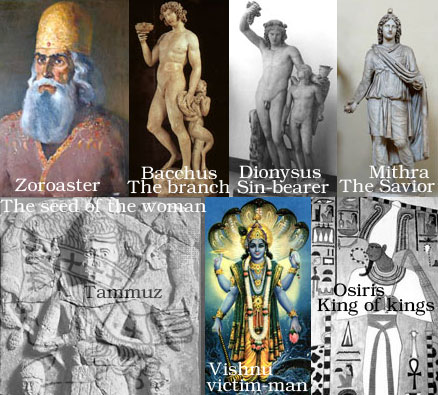
And the LORD God said unto the serpent, Because thou hast done this, thou art cursed above all cattle, and above every beast of the field; upon thy belly shalt thou go, and dust shalt thou eat all the days of thy life: and I will put enmity between thee and the woman, and between thy seed and her seed; it shall bruise thy head, and thou shalt bruise his heel. (Genesis 3)
The system of worship has its origin in the legend of Nimrod, and his wife Semiramis.
Semiramis
The Chaldean Mysteries can be traced up to the days of Semiramis, who lived only a few centuries after the flood, and who is known to have impressed upon them the image of her own depraved and polluted mind. Ammianus Marcellinus compared with Justinus, Historia and Eusebius’ Chronicle. Eusebius says that Ninus and Semiramis reigned in the time of Abraham. That beautiful but abandoned queen of Babylon was not only herself a paragon of unbridled lust and licentiousness, but in the Mysteries which she had a chief hand in forming, she was worshipped as Rhea, the great ‘MOTHER’ of the gods, with such atrocious rites as identified her with Venus, the MOTHER of all impurity, and raised the very city where she had reigned to a bad eminence among the nations, as the grand seat at once of idolatry and consecrated prostitution. Alexander Hislop, The Two Babylons
Nimrod was an apostate and rebelled against God, like his father Cush. Eventually Nimrod was put to death for his evil deeds, and according to the ancient patriarchal system, parts of his body were sent to various cities as a warning. His wife Semiramis fled, but spread the rumor that he had ascended to heaven, where he had become one with the sun. When Semiramis later gave birth to a son, she claimed that it was the reincarnation of her deified husband, and that he had returned as Savior of the human race. She was later deified as the mother of god who had ascended into heaven as the queen of heaven.
This myth introduced the worship of the fertility goddess and her gifts of sex and procreation. Consequently, the queen of heaven and her apostate religious system would effectively diminish the population of virgin women. Semiramis also established her own society of female devotees (vestal virgins) who would later be called by the Chaldean term Nun, which means Daughters of Nimrod. This Babylonian religion required a Gnostic hierarchy of priests to control the spread of spiritual knowledge and to direct the necessary sacraments of the religion…
[The] object was to bind all mankind in blind and absolute submission to a hierarchy entirely dependent on the sovereigns of Babylon. In the carrying out of this scheme, all knowledge, sacred and profane, came to be monopolized by the priesthood, who dealt it out to those who were initiated in the Mysteries exactly as they saw fit, according as the interests of the grand system of spiritual despotism they had to administer might seem to require. Thus the people, wherever the Babylonian system spread, were bound neck and heel to the priests. The priests were the only depositaries of religious knowledge; they only had the true tradition by which the writs and symbols of the public religion could be interpreted; and without blind and implicit submission to them, what was necessary for salvation could not be known. Alexander Hislop, The Two Babylons
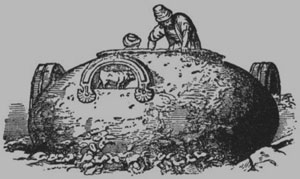 With the birth of the Babylonian antichrist came the traditional celebration of his birthday after the winter solstice on December 25th. When Tammuz reached his 40th year he was killed by a wild boar; providing a counterfeit fulfillment of the 2nd half of the prophecy, “and you shall bruise him on the heel.” His worshippers lamented over his death for 40 days (one day for each of his years) before he was resurrected/reincarnated. This established a new ritual of worship by offering wafers to the queen of heaven; 40 days of abstinence (lent) to memorialize weeping for Tammuz, followed by a feast to celebrate his resurrection. During these celebrations the people would exchange Ishtar eggs (dipped in the blood of sacrificed newborns) to symbolize new life.
With the birth of the Babylonian antichrist came the traditional celebration of his birthday after the winter solstice on December 25th. When Tammuz reached his 40th year he was killed by a wild boar; providing a counterfeit fulfillment of the 2nd half of the prophecy, “and you shall bruise him on the heel.” His worshippers lamented over his death for 40 days (one day for each of his years) before he was resurrected/reincarnated. This established a new ritual of worship by offering wafers to the queen of heaven; 40 days of abstinence (lent) to memorialize weeping for Tammuz, followed by a feast to celebrate his resurrection. During these celebrations the people would exchange Ishtar eggs (dipped in the blood of sacrificed newborns) to symbolize new life.
The word that came to Jeremiah for all the Jews living in the land of Egypt…saying, “Thus says the LORD of hosts, the God of Israel, ‘You yourselves have seen all the calamity that I have brought on Jerusalem and all the cities of Judah; and behold, this day they are in ruins and no one lives in them, because of their wickedness which they committed so as to provoke Me to anger by continuing to burn sacrifices and to serve other gods whom they had not known, neither they, you, nor your fathers. Yet I sent you all My servants the prophets, again and again, saying, ‘Oh, do not do this abominable thing which I hate.’ But they did not listen or incline their ears to turn from their wickedness, so as not to burn sacrifices to other gods. Therefore My wrath and My anger were poured out and burned in the cities of Judah and in the streets of Jerusalem, so they have become a ruin and a desolation as it is this day.’”
‘Have you forgotten the wickedness of your fathers, the wickedness of the kings of Judah, and the wickedness of their wives, your own wickedness, and the wickedness of your wives, which they committed in the land of Judah and in the streets of Jerusalem? But they have not become contrite even to this day, nor have they feared nor walked in My law or My statutes, which I have set before you and before your fathers.’ Therefore thus says the LORD of hosts, the God of Israel, ‘Behold, I am going to set My face against you for woe, even to cut off all Judah.’
Then all the men who were aware that their wives were burning sacrifices to other gods, along with all the women who were standing by, as a large assembly, including all the people who were living in Pathros in the land of Egypt, responded to Jeremiah, saying, ‘As for the message that you have spoken to us in the name of the LORD, we are not going to listen to you! But rather we will certainly carry out every word that has proceeded from our mouths, by burning sacrifices to the queen of heaven and pouring out drink offerings to her, just as we ourselves, our forefathers, our kings and our princes did in the cities of Judah and in the streets of Jerusalem; for then we had plenty of food and were well off and saw no misfortune. But since we stopped burning sacrifices to the queen of heaven and pouring out drink offerings to her, we have lacked everything and have met our end by the sword and by famine.’
‘And’, said the women, ‘when we were burning sacrifices to the queen of heaven and were pouring out drink offerings to her, was it without our husbands that we made for her sacrificial cakes in her image and poured out drink offerings to her?’
Then Jeremiah said to all the people, to the men and women - even to all the people who were giving him such an answer - saying, ‘As for the smoking sacrifices that you burned in the cities of Judah and in the streets of Jerusalem, you and your forefathers, your kings and your princes, and the people of the land, did not the LORD remember them and did not all this come into His mind? So the LORD was no longer able to endure it, because of the evil of your deeds, because of the abominations which you have committed; thus your land has become a ruin, an object of horror and a curse, without an inhabitant, as it is this day. Because you have burned sacrifices and have sinned against the LORD and not obeyed the voice of the LORD or walked in His law, His statutes or His testimonies, therefore this calamity has befallen you, as it has this day.’ (Jeremiah 44)
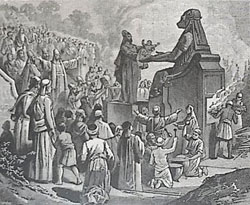 |
Worshippers of Baal (Tammuz, Ninus, Bacchus, Kronos, Molech, Baal, etc.) offer their first born as a sacrifice; a new life offering. |
|---|---|
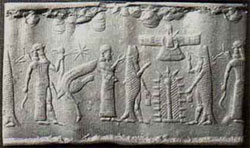 |
Dagon priests keeping the tree of life. The fish-god is the assumed inheritor of knowledge lost in the flood. |
Sun worship is often seen as primitive, but is in fact a sophisticated awe inspiring system of worship which appeals to the senses and captivates the mind with its grandiose ceremonies. This system of worship has been perpetuated throughout generations, and in our day forms the basis of all the religions such as Earth Religions, Buddhism, Hinduism, and Catholicism. In the mysteries of Catholicism, sun worship reaches its highest form. The names of the gods have changed, but the system of worship remains the same.
As the sungod (Nimrod) plunged into the waters of the river (Euphrates), so the reincarnated son plunged into the waters of the womb to be worshipped as the saviour. The cycle of the sun represents this ancient cycle of the sun rising (Brahma), the sun at the meridian (Siva) and the sun setting (Vishnu). At night, the sun rests in the womb of the ocean in the darkness of the underworld (representing the death and suffering of the sungod). As god of the ocean (Poseidon, Neptune), he was also worshipped as the fishgod Dagon (Dag = fish, On = the name of sungod as he was called in Egypt) who had plunged into the waters of the womb to be reborn. The most prominent form of worship in Babylon was dedicated to Dagon, later known as Ichthys, or the fish. In Chaldean times, the head of the church was the representative of Dagon, he was considered to be infallible, and was addressed as Your Holiness. Nations subdued by Babylon had to kiss the ring and slipper of the Babylonian god-king. The same powers and the same titles are claimed to this day by the Dalai Lama of Buddhism, and the Pope. Moreover, the vestments of paganism, the fish mitre and robes of the priests of Dagon are worn by the Catholic bishops, cardinals and popes today.
And the whole earth was of one language, and of one speech. And it came to pass, as they journeyed from the east, that they found a plain in the land of Shinar; and they dwelt there. And they said one to another, “Go to, let us make brick, and burn them thoroughly.” And they had brick for stone, and slime had they for morter. And they said, “Go to, let us build us a city and a tower, whose top may reach unto heaven; and let us make us a name, lest we be scattered abroad upon the face of the whole earth.” And the LORD came down to see the city and the tower, which the children of men builded. And the LORD said, "Behold, the people is one, and they have all one language; and this they begin to do: and now nothing will be restrained from them, which they have imagined to do. Go to, let us go down, and there confound their language, that they may not understand one another’s speech." So the LORD scattered them abroad from thence upon the face of all the earth: and they left off to build the city. Therefore is the name of it called Babel; because the LORD did there confound the language of all the earth: and from thence did the LORD scatter them abroad upon the face of all the earth. (Genesis 11)
The religion of Babylon naturally scattered to every corner of the earth as well; the mother goddess and the child became idols in every pagan culture. Here are some examples.
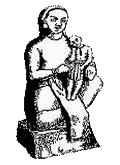 |
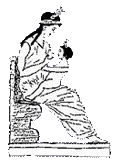 |
|---|---|
| Ishtar and Tammuz in Babylon/Assyria. | Isis and Horus in Egypt. |
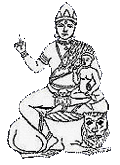 |
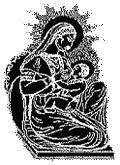 |
| Isi and Iswara in India. | Devaki and Krishna in India. |
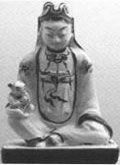 |
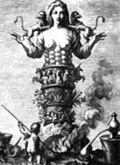 |
| Shing-Moo in China. | Artemis and Diana in Ephesus. |
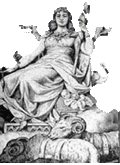 |
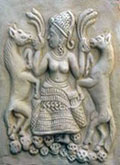 |
| Frigga and Baldr in Scandinavia (Norse). | Astarte and Baal in Phoenicia. |
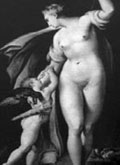 |
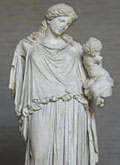 |
| Aphrodite and Eros in Greece. | Ceres and Plutus in Greece. |
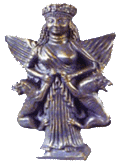 |
|
| Anahita and Mithra in Persia. |
![The seventeenth numbered major trump is called *Les Etoiles*, *the Stars*, and portrays a young girl kneeling with one foot in water and the other on land, her body somewhat suggesting the swastika. She has two urns, the contents of which she pours upon the land and sea. Above the girl's head are eight stars, one of which is exceptionally large and bright. Count de Gebelin considers the great star to be Sothis or Sirius. The other seven are the sacred planets of the ancients. He believes the female figure to be Isis in the act of causing the inundations of the Nile which accompanied the rising of the Dog Star. The unclothed figure of Isis may well signify that Nature does not receive her garment of verdure until the rising of the Nile waters releases the germinal life of plants and flowers. The bush and bird (or butterfly) signify the growth and resurrection which accompany the rising of the waters. In the pseudo-Egyptian Tarot the great star contains a diamond composed of a black and white triangle, and the flowering bush is a tall plant with a trifoliate head upon which a butterfly alights. Here Isis is in the form of an upright triangle and the vases have become shallow cups. The elements of water and earth under her feet represent the opposites of Nature sharing impartially in the divine abundance. [Manly P. Hall, The Secret Teachings of All Ages]](../../img/tarot-the-star.jpg)
![The second numbered major trump is called *La Papesse*, *the Female Pope*, and has been associated with a curious legend of the only woman who ever sat in the pontifical chair. Pope Joan is supposed to have accomplished this by masquerading in male attire, and was stoned to death when her subterfuge was discovered. This card portrays a seated woman crowned with a tiara surmounted by a lunar crescent. In her lap is the Tora, or book of the Law (usually partly closed), and in her left hand are the keys to the secret doctrine, one gold and the other silver. Behind her rise two pillars (Jachin and Boaz) with a multicolored veil stretched between. Her throne stands upon a checkerboard floor. A figure called Juno is occasionally substituted for La Papesse. Like the female hierophant of the Mysteries of Cybele, this symbolic figure personifies the Shekinah, or Divine Wisdom. In the pseudo-Egyptian Tarot the priestess is veiled, a reminder that the full countenance truth is not revealed to uninitiated man. A veil also covers one-half of her book, thus intimating that but one-half of the mystery of being can be comprehended. [Manly P. Hall, The Secret Teachings of All Ages]](../../img/tarot-high-priestess.jpg)